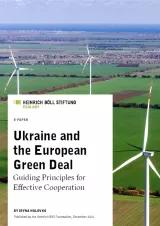A different policy mix of climate protection in the U.S. and EU creates tensions that make a close alliance very difficult. The deep political divide in the U.S. also raises doubts about the durability of climate policy cooperation.

The opinions expressed in this article are solely that of the author/s and do not necessarily reflect the views of the Heinrich Böll Foundation or other participants of the 22nd Foreign Policy Conference.
After the four challenging years of Donald Trump's presidency, expectations were high in Europe, and especially in Germany, at the beginning of 2021, not least concerning climate policy. US president Joe Biden had signed the renewed accession to the Paris Climate Agreement as one of his first acts in office. Furthermore, he filled his cabinet with outstanding experts, and his climate envoy John Kerry enjoys worldwide approval.
People had been waiting for an extremely long time for the richest and most powerful country on earth to become an ally in climate protection, and it is therefore understandable that many had high hopes for the Biden administration.
A transatlantic climate agenda
A policy paper commissioned by the Bundestag parliamentary group Alliance 90/The Greens outlined eight essential points of a potential transatlantic climate agenda. Based on this, German Green Party co-leaders Robert Habeck and Annalena Baerbock wrote an opinion piece calling for a transatlantic alliance for climate neutrality.
The majority of the proposals consist of increased political, technological and social exchange. The value lies in mutual learning and in encouraging ambitious climate action, although the latter could, in principle, also be unilateral, or independent of the transatlantic link. Joint climate finance initiatives, such as supporting South Africa in its difficult coal phase-out, are also important.
However, these activities cannot hide profound economic and climate policy tensions between the US and the EU that arise from different climate policy approaches, as well as different environmental and technological agendas, which are rooted in the respective political economies on both sides of the Atlantic.
Economic and climate policy tensions between the US and the EU
Building on an analysis by Adam Tooze, I will outline current developments in order to draw conclusions for the prospects of a transformative transatlantic climate cooperation that, beyond diplomatic signals, becomes relevant in real economic terms for the socio-ecological transformation of the economy. Finally, I would like to look ahead and ask the question: Can Europe rely on an alliance with the US on its path to climate neutrality?
Tooze elaborates on how much the EU and the US diverge in terms of climate policy, noting that the EU looks back on a quarter of a century of common climate policy, going back to the signing and ratification of the Kyoto Protocol. At the heart of the EU's climate policy is the Emissions Trading Scheme (ETS), which so far covers 40 per cent of EU emissions with regard to the sectors of power generation and industry, as well as intra-European air traffic. According to the European Commission's plans, the transport and buildings sectors are to be integrated into the ETS. The ETS puts a price on greenhouse gas emissions, and after several reforms the system is now operational to the point where prices were around 90 euros per tonne in December 2021. All this has been made possible on the basis of widespread social acceptance across the democratic political spectrum of the scientific facts of climate change and the need to reduce emissions..
Climate policy in the US
In the US, on the other hand, climate policy has become a pawn in the country's profound political divide. Under the influence of an influential fossil fuel lobby, the Republicans have become an anti-climate change party, and have used their power to block climate policy, both in the US Congress and in Republican-ruled states.
Attempts to pass climate change legislation with emissions trading failed miserably under the Obama administration. Regional emissions trading schemes in California and some states in the Northeast remain largely ineffective. In their influential book Making Climate Policy Work (2021), US political scientist David Victor and his co-author Danny Cullenward call these schemes "Potemkin markets", which simulate climate protection while real emissions reductions are driven by other policy instruments.
Even on the side of the US Democrats, who are normally more ambitious regarding climate policy, CO2 pricing (as emissions trading or a CO2 tax) is now extremely unpopular and without any chance of getting passed as legislation. The draft of a Green New Deal, as introduced in the US House of Representatives by the left-wing Democratic Congresswoman Alexandria Ocasio-Cortez, relies instead on the ability of the US to take out government loans on a large scale, thus financing climate-friendly infrastructure, and subsidies for climate protection measures of all kinds.
Joe Biden also adopted this orientation as a presidential candidate, and later as US President. With his decades of experience as a US senator and vice-president, Biden packaged climate protection measures into two large-scale spending bills.
Yet Biden's legislative initiatives did not work. The first package of legislation, the bipartisan Infrastructure Bill, was stripped of all regulatory elements in congressional negotiations, including the Clean Electricity Standard (CES), which would force electricity suppliers to source a certain percentage of their electricity from climate-friendly sources.
The CES was then supposed to be passed in the second legislative package, the American Families Plan, which was expected to pass the Senate with the votes of all Democrats and the decisive vote of US Vice-President Kamala Harris. But Joe Manchin, Democratic senator for West Virginia, first got this provision removed, and then announced shortly before Christmas, in an interview on Fox News, that he could not agree to the whole package.
Joe Biden is thus faced with a shambles of a climate policy. US emissions have risen steeply in 2021. Even if, with further "radioactive" concessions, he somehow manages to wrangle agreement from Manchin for an even more slimmed-down version of the Families Plan, it is safe to assume that it will not include regulatory requirements such as the CES. This has led experts to describe US climate policy as ‘all carrots and no sticks’. Climate protection measures may be subsidised, but nothing is considered that could even remotely impose a burden on industries and households.
Imbalance leads to competitive disadvantages
If companies on the US side of the Atlantic are subsidised for climate protection, while companies in the same sector on the European side have to pay for emissions, then even with comparable levels of ambition, an imbalance arises that distorts competition, at least for tradable, emission-intensive goods such as steel, cement, ceramics or metals. This imbalance is the result of different policy instruments for climate protection based on differences in both the political system and political economy between the two sides of the Atlantic.
Avoiding competitive disadvantages as a result of climate protection is the goal of the EU’s Carbon Border Adjustment Mechanism (CBAM), a type of climate tariff intended to compensate for such differences in CO2 pricing at Europe's external borders. However, even John Kerry made it clear on his first trip to Europe that the Biden administration opposes CBAM. Steelworkers are an important constituency for Biden, and with the midterm elections coming up in November 2022, the US President cannot afford to alienate them.
Diverging climate policy instruments
Even though the EU and the US agreed on a negotiation process on steel and aluminium shortly before the 2021 G20 summit in Rome, which as well as climate protection aims to eliminate overcapacities and implements a common front towards China, the problem of the fundamentally different instrumentation of climate policy on both sides of the Atlantic remains unresolved. While there is a willingness on the EU side to convert other climate policy instruments (such as the CES) into CO2 price equivalents, this cannot work given the US's ‘only carrots, no sticks’ policy. Climate policy efforts by the US government in the form of subsidies are important and should be applauded, and they may eventually have similar climate policy effects; however, they do not solve the problem of competitive distortion between industries on both sides of the Atlantic.
In addition, the differences in the choice of climate policy instruments identified here should not obscure fundamental differences in the integration of the EU and the US into the global fossil energy economy. Not least thanks to the fracking boom promoted under Obama, the US is a fossil superpower that has considerably more to lose from global decarbonisation than Europe (see also Adam Tooze).
It is no surprise that the US is "unreliable" in terms of climate policy. The basic constant is the vacillation between, on the one hand, acknowledging the necessity of climate policy, combined with the claim to a global leadership role, and, on the other hand, the interests of the fossil industries, especially the oil and gas corporations, regarding the further extraction of the fossil fuel that is destroying our climate. Climate protection means that immense assets must stay in the ground. Particularly at risk in this regard are the US deposits of shale gas and oil, which have comparatively higher production costs than, for example, oil and gas on the Arabian Peninsula or in Russia.
Prospects for a transatlantic climate alliance
What does all this mean for the prospects of a transatlantic climate alliance?
- It's politics, stupid! The EU and the US will pursue the goal of decarbonisation with different policy instruments and at different speeds. In the US, a climate policy of stop-and-go will remain, driven by conflicting interests. In Europe, we can rely on the power of the EU institutions, which would lead us to expect a relatively continuous decarbonisation "on schedule".
- Some trade policy decoupling in the form of CBAM is probably necessary to enable this multi-speed climate policy - at least in those sectors where CO2 pricing is a significant cost factor. A transparent border adjustment that demonstrably does not serve protectionist purposes should at least be comprehensible to the climate policy well-wishers of the Biden administration. Only in this way can Europe continue to play the climate policy leadership role that the US is once again incapable of.
- By this logic, a climate club including the US on the basis of a uniform CO2 price and corresponding external protection - as proposed by the scientific advisory board of the Ministry of Economics - cannot function. It can, however, be a forum for continuous climate policy dialogue in which sectoral policies and measures are discussed and, if necessary, technological standards are coordinated. It can therefore be an instrument of soft policy coordination rather than a new type of free trade area underpinned by hard trade policy measures.
German foreign policy, which now also includes international climate policy, is confronted with new challenges, as highlighted by this analysis. The transatlantic orientation that is often so fundamental cannot be its guiding star for climate policy. While the US has been a dependable partner for Germany and Europe in security policy for decades, it is an unreliable bedfellow in climate policy.
Biden and Kerry will certainly strive to do the right thing on climate policy within their means. But so far, a senator from their own party has essentially pulled the rug out from under them. If the Democrats lose the midterm elections, as is currently feared, they will continue to become lame ducks – not least in terms of climate policy. In addition, in 2024, a return of Trump cannot be ruled out, based on questionable electoral rules that give each Republican vote a far heavier weight than the votes cast for the Democrats.
As difficult as it may be for some transatlanticists, Europe will have to continue to pursue an independent direction on foreign climate policy, albeit in constant dialogue and close exchange with the US. Nevertheless, where necessary, it must not shy away from conflict for the sake of the climate.
Read the original article in German here >>


